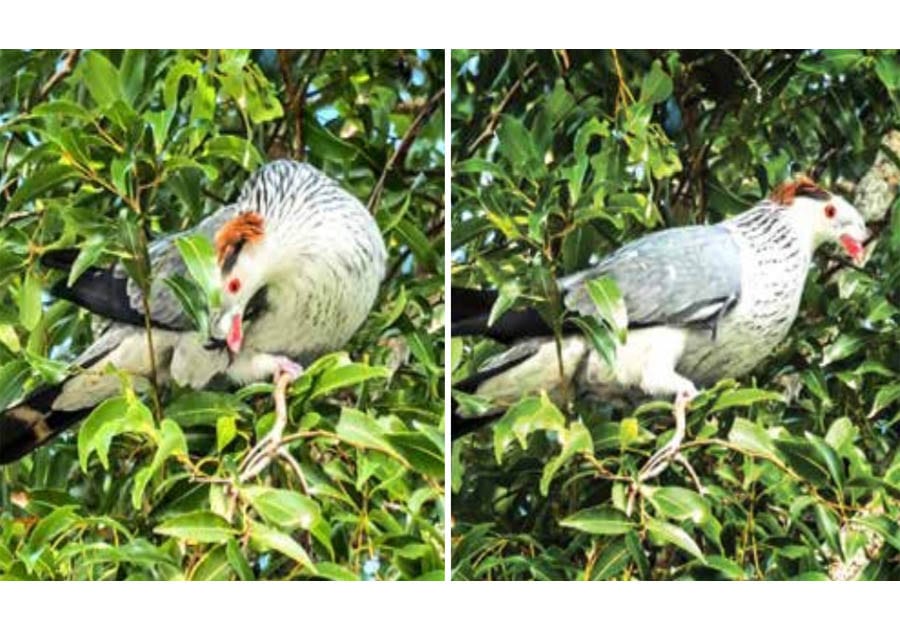Just recently in the month of July, I received word that rare visitors were on the island and feeding on the fruit of the Dark Corkwood trees growing near the Ranger Station. I picked up my camera and went to investigate. First, I had to find the Corkwood trees then I waited for about 45 minutes with nothing happening. Then flying in and landing in the canopies of the very tall trees were four Topknot Pigeons which proceeded to gorge on the black, olive-like fruit. At the same time as their visit, Rose-crowned Fruit-Doves appeared and were feeding on the same berries. After a few weeks when the berries were finished, the birds were gone. It is not very often that these pigeons come to Bribie Island now, although several years ago they were a more common sight arriving in huge flocks. I had a report of up to twenty birds flying in on the recent visit.
Topknot Pigeons, sometimes called Flock Pigeons are large, grey birds 40-45 cm in length and weighing 470-600 g. Their most prominent feature is their crest which is divided into 2 parts. Falling over the beak is a clump of grey feathers and swept back over the neck is a distinctive reddish crest. Bills and eyes are red and at the base of the bill are two quite large blue bumps. Tails are long and squarish with dark feathers and a wide whitish band which is visible when flying. Breasts and necks are streaked, and wings have darker grey feathers. They are usually silent but when feeding you can sometimes hear low screeching sounds and at other times their calls are more like grunts. Females are like the males but are a little smaller with a smaller crest.
These nomadic birds are found only in Australia along the east coast from Cape York to the south of Sydney. The most likely places to find Topknots are in rainforests, eucalypt forests and regrowth areas when native fruit is in season. They are more common in Queensland and northern NSW where it is warmer. In recent years large flocks have been visiting Gippsland in Victoria each summer. There have been only a few rare sightings in Tasmania.//Topknots are frugivorous (fruiteating) birds which feed on a variety of bush fruits and berries such as native figs, Blueberry Ash, Palms, Dark Corkwood and many others. They have also developed a liking for Camphor Laurel berries. Long distances are travelled by high-flying flocks in their search for ripe berries high up in the canopies. Large quantities of fruit are dropped but Topknots do not feed on the ground. While feeding they are quite active flapping their wings and even eating some of the fruit upside down. Seeds pass through their bodies intact and drop to the ground. This aids in the regrowth of our native trees. They have also taken part in the spreading of Camphor Laurel which is a declared weed.
June to January are favoured months for Topknots to nest. Males perform an involved mating ritual by using their topknots in showy displays, marching, bowing and flying high to attract the attention of the females. The monogamous pairs work together to build flat nests of vines and twigs hidden in a dense bush about 2-12 m from the ground and are quite hard to find. A clutch of one white egg is laid and incubated by both parents for 22-24 days. Both parents then feed their young by regurgitating pigeon milk from their crops. Pigeon milk is a nutritious liquid, looking a little like cottage cheese coming from the lining of the crop. A pair of pigeons cannot produce enough milk to feed several chicks which limits them to laying just one egg. When flying towards the nest adult birds call to their young to alert them of their presence. If the nest is in danger adults will crouch protectively over their young warding off any intruders. Young birds fledge at 4-6 weeks.
Crested Pigeons which are common in our area are often mistakenly called “Topknots”.
Large scale land clearing and hunting for food depleted much of their population in earlier times and flocks became smaller. Numbers have recovered somewhat since they began eating the berries from the invasive, introduced Camphor Laurel trees. Even though populations seem to be fluctuating conservation status in their Queensland and NSW habitat is secure at present.
My next article will be about Rosecrowned Fruit-Doves which were feeding on the Dark Corkwood trees at the same time as the Topknots.
